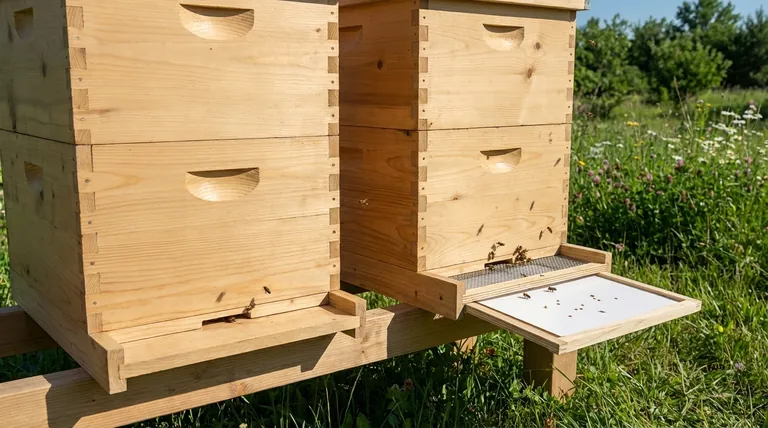In beekeeping, you have two primary choices for a hive's foundation. These are the solid bottom board and the screened bottom board. While both serve as the floor of the hive, they offer fundamentally different approaches to hive ventilation and pest management.
The core decision between a solid and a screened bottom board is a strategic choice between the traditional simplicity and heat retention of a solid base versus the enhanced ventilation and integrated pest management capabilities offered by a screened design.

The Solid Bottom Board: The Traditional Standard
A solid bottom board is the classic, original design. It is simply a solid piece of wood that serves as the floor for the entire hive stack.
Core Advantage: Simplicity and Insulation
The primary benefit of a solid board is its ability to conserve heat within the hive. By preventing drafts, it helps the colony maintain its crucial cluster temperature, which is especially important during cold winters. Its simple design also means there are no moving parts to manage.
Primary Drawback: Reduced Airflow
The lack of ventilation is the main weakness of a solid bottom board. In hot and humid climates, this can lead to overheating, forcing bees to expend energy fanning the hive to cool it down. This can also create excess moisture, which can be detrimental to colony health.
The Screened Bottom Board: A Modern Solution
A screened bottom board, sometimes called an Integrated Pest Management (IPM) board, replaces the solid wood floor with a durable wire screen. Most models come with a removable solid insert, often called a "sticky board" or tray.
Advantage 1: Superior Ventilation
The screen provides excellent air circulation throughout the hive. This is highly beneficial in warm weather or during hive transportation, as it helps keep the colony cool and reduces the stress on the bees.
Advantage 2: Integrated Pest Management
This is the most significant advantage. Varroa mites, a major threat to honeybees, will occasionally fall off their host bee. With a screened bottom, these mites fall through the screen and out of the hive, unable to climb back in. This provides a passive method of reducing the mite population.
Advantage 3: Monitoring and Hive Insights
The removable insert, or sticky board, is a powerful diagnostic tool. By coating it with a sticky substance and sliding it under the screen for a set period, you can perform a "mite drop" count. This allows you to accurately assess the level of Varroa mite infestation in your hive without disturbing the colony.
Understanding the Trade-offs
Neither bottom board is universally superior; the right choice depends entirely on your environment and beekeeping philosophy.
Climate is the Key Factor
In colder climates, a solid bottom board's heat retention can be a significant asset for winter survival. While a screened board can be used, the insert must be kept in place during the cold months to prevent drafts that could chill the brood.
In hot climates, the superior ventilation of a screened bottom board is almost always the better choice to prevent the hive from overheating.
Pest Control Strategy
A screened bottom board is a tool, not a complete solution, for pest control. It helps reduce Varroa mite numbers and can deter small hive beetles, which dislike the increased light and airflow. However, it does not eliminate the need for active mite treatments when thresholds are reached.
Making the Right Choice for Your Apiary
Your choice should be a deliberate decision based on your specific goals and local conditions.
- If your primary focus is simplicity and winter survival in a cold climate: A solid bottom board is a reliable and straightforward option.
- If your primary focus is proactive pest management and hive health in a warm climate: A screened bottom board offers clear advantages for ventilation and mite control.
- If your primary focus is versatility and data-driven beekeeping: A screened bottom board with its removable insert gives you the most flexibility, allowing you to adapt to changing seasons and monitor pest levels effectively.
Ultimately, understanding how each component impacts your hive's internal environment empowers you to build a healthier, more resilient colony.
Summary Table:
| Feature | Solid Bottom Board | Screened Bottom Board |
|---|---|---|
| Primary Advantage | Excellent heat retention for winter | Superior ventilation & pest management |
| Best For Climate | Cold climates | Warm, humid climates |
| Pest Control | No direct benefit | Passive Varroa mite reduction |
| Key Drawback | Can cause overheating in summer | Requires insert for cold weather |
Equip Your Apiary with the Right Foundation
Choosing the correct bottom board is a critical step for hive health and productivity. HONESTBEE supplies durable, high-quality solid and screened bottom boards to commercial apiaries and beekeeping equipment distributors through our wholesale-focused operations.
We provide the reliable equipment you need to build resilient colonies, whether your priority is winter survival or proactive pest management.
Contact HONESTBEE today to discuss your bulk supply needs and optimize your hive foundations.
Visual Guide

Related Products
- Langstroth Solid Bottom Board for Beekeeping
- Langstroth Screen Bottom Board for Beekeeping Wholesale
- Solid Bottom Board Australian Pine Wood Langstroth Bottom Board for Wholesale
- Australian Pine Wood Langstroth Screen Bottom Board for Wholesale
- HONESTBEE Professional Long Handled Hive Tool with Precision Cutting Blade
People Also Ask
- What is the purpose of a solid bottom board in a hive? Essential for Winter Survival & Insulation
- What are the characteristics of a solid bottom board? A Guide to Hive Foundation & Climate Control
- How do honeybees adapt to different bottom board types in terms of temperature regulation? Optimize Your Hive Climate
- What is the recommended approach for choosing between different types of hive boards if you have multiple hives?
- What is the suggested approach for choosing hive boards if you have only 1 or 2 hives? Test Both Types to Find Your Perfect Fit.



















